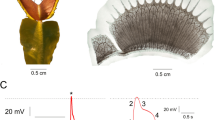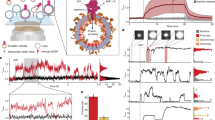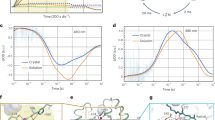Abstract
IN a variety of tissues, electrical events seem to be more closely associated with the active transport of ions and with metabolism than with the concentration gradients of ions per se. This is evident in the generation of some transepithelial potentials, for example in gastric mucosa1; in the hyperpolarization of sodium-loaded (and pumping) nerve and muscle cells2–4 and in the rapid depolarization produced by respiratory inhibitors in fungi, algae and higher plant cells5–7. Such phenomena may be described in terms of the electrogenic ion pump which separates charges across the cell membrane, thus generating a potential gradient along which ions will move. What is not certain, however, is whether the energy for this particular mode of ion transport is provided by ATP—which clearly drives the neutral coupled pumping of ions in many tissues8—or comes more directly from electron transfer, as suggested by Conway's “redox pump” hypothesis9,10. We have examined this question for the fungus Neurospora, in which the relationship between metabolic and electrical events seems particularly close.
This is a preview of subscription content, access via your institution
Access options
Subscribe to this journal
Receive 51 print issues and online access
$199.00 per year
only $3.90 per issue
Buy this article
- Purchase on Springer Link
- Instant access to full article PDF
Prices may be subject to local taxes which are calculated during checkout
Similar content being viewed by others
References
Rehm, W. S., Ann. NY Acad. Sci., 137, 591 (1966).
Adrian, R. H., and Slayman, C. L., J. Physiol., 184, 970 (1966).
Thomas, R. C., J. Physiol., 201, 495 (1969).
Rang, H. P., and Ritchie, J. M., J. Physiol., 196, 183 (1968).
Slayman, C. L., J. Gen. Physiol., 49, 93 (1965).
Kitasato, H., J. Gen. Physiol., 52, 60 (1968).
Etherton, B., and Higinbotham, N., Science, 131, 409 (1960).
Skou, J. C., Physiol. Rev., 45, 596 (1965).
Conway, E. J., Fed. Proc., 23, 680 (1964).
Conway, E. J., Brady, T. G., and Carton, E., Biochem. J., 47, 369 (1950).
Slayman, C. L., J. Gen. Physiol., 49, 69 (1965).
Slayman, C. W., and Tatum, E. L., Biochim. Biophys. Acta, 88, 578 (1964).
Marquardt, D. W., J. Soc. Indust. Appl. Math., 11, 431 (1963).
Chance, B., and Williams, G. R., J. Biol. Chem., 217, 429 (1955).
Strehler, B. L., in Methods of Enzymatic Analysis (edit. by Bergmeyer, H. U.), 559 (Academic Press, New York, 1965).
Denny, F. E., Contrib. Boyce Thompson Inst., 5, 95 (1933).
Ohnishi, E., Sottocasa, G., and Ernster, L., Bull Soc. Chin. Biol., 48, 1189 (1966).
Durbin, R. P., J. Gen. Physiol., 51, 233s (1968).
Forte, J. G., Adams, P. H., and Davies, R. E., Biochim. Biophys. Acta, 104 25 (1965).
Author information
Authors and Affiliations
Rights and permissions
About this article
Cite this article
SLAYMAN, C., LU, CH. & SHANE, L. Correlated Changes in Membrane Potential and ATP Concentrations in Neurospora. Nature 226, 274–276 (1970). https://doi.org/10.1038/226274a0
Received:
Issue Date:
DOI: https://doi.org/10.1038/226274a0
This article is cited by
-
Biology, structure and mechanism of P-type ATPases
Nature Reviews Molecular Cell Biology (2004)
-
Energy coupling for membrane hyperpolarization in Lemna: respiration rate, ATP level and membrane potential at low oxygen concentrations
Planta (1983)
-
Energy coupling for membrane hyperpolarization in Lemna: Evidence against an ATP-fueled electrogenic pump as the exclusive mechanism
Planta (1981)
-
Current-voltage relationships for the plasma membrane and its principal electrogenic pump inNeurospora crassa: I. Steady-state conditions
The Journal of Membrane Biology (1978)
-
Chloride transport and the membrane potential in the marine alga,Halicystis parvula
The Journal of Membrane Biology (1977)
Comments
By submitting a comment you agree to abide by our Terms and Community Guidelines. If you find something abusive or that does not comply with our terms or guidelines please flag it as inappropriate.



